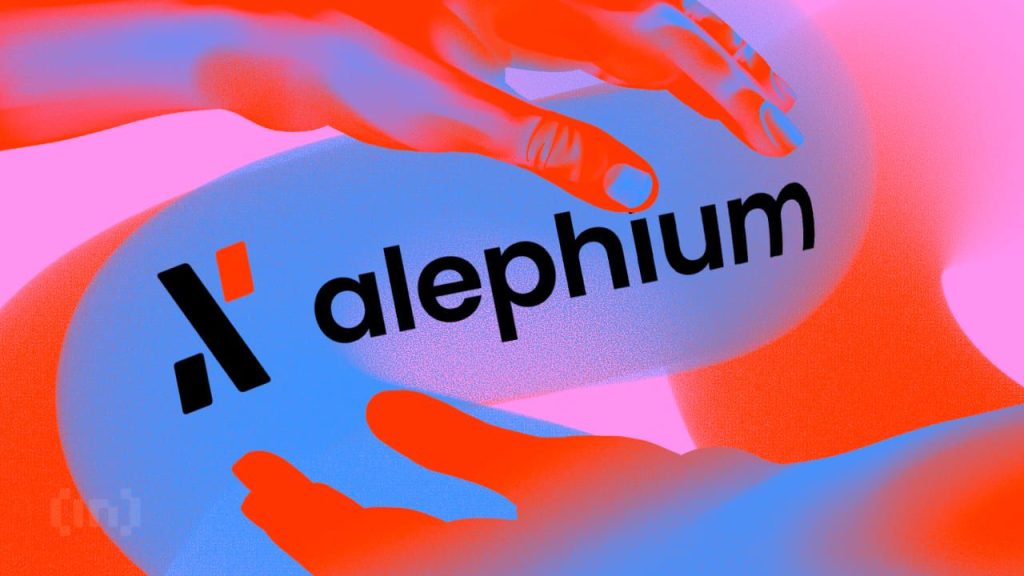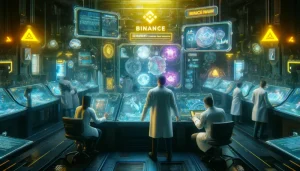Alephium’s Game-Changing Tech & Vision for Decentralized World

[ad_1]
Editorial Note: The following content does not reflect the views or opinions of BeInCrypto. It is provided for informational purposes only and should not be interpreted as financial advice. Please conduct your own research before making any investment decisions.
Alephium is a Layer 1 blockchain, live since November 2021, which avoids common industry compromises, offering simultaneously scalability & expressivity, strong security & robust decentralization.
It differentiates itself with a strong tech proposition: from its unique sharding algorithm called Blockflow, its energy efficiency thanks to Proof-of-Less-Work, its unique Stateful UTXO model & more that will be detailed below!
But it’s not only the tech. It has a very strong focus on User Experience through its suite of wallets, a strong community, and a striving ecosystem of dApps (including DEX, NFT marketplace, games & others), a bridge to Ethereum with more than 6000 holders of the wrapped asset & millions of TVL.
Its hackathon with almost 100 participants is currently running, and the next network upgrade reducing the blocktime to 16 seconds and introducing gasless transactions is coming in Q1!
And now, let’s dive into the details.
Security & Expressivity: Stateful UTXO
Alephium is programmable & secure. Alephium introduces the stateful UTXO model offering layer-1 scalability and the same level of programmability as the account model implemented on ETH, whilst being more secure.
The classical UTXO (Unspent Transaction Output) model is famously used to keep track of accounting in the Bitcoin blockchain. It is also found in Bitcoin Cash, Zcash, Litecoin and more…
In UTXO, there are no accounts nor balances at the protocol layer, just transactions. Coins are stored as a ledger of unspent transactions output (UTXO) & new transactions consume existing UTXOs to produce new UTXOs. This model is simple to understand conceptually, it scales well and is very transparent. It has a few downsides: it doesn’t have a state and is not expressive enough for developers, meaning it’s hard to build complex programs on top of it.
The account model is more intuitive and closer to a classic database. It records the increase/decrease in balances of addresses when transactions happen. This structure is more accessible and easier to master for developers, enabling a more “expressive” system: developers can build dApps more easily. The account model also has limitations: parallel execution is hard, MEV is a constant drag, and it often lacks enough security checks to be secure at the smart contract level.
Alephium combines the security of the UTXO model with the expressiveness of the account model. It achieves this by actually using both… but for different things! UTXOs are used for assets/tokens and the account model for smart contracts and states.
The sUTXO is a massive improvement for developers as they can interact with an upgraded account model specifically dedicated to token handling. Lastly, the sUTXO model gives a solid foundation to build smart contracts by giving an assurance of secure asset management.
Scalability and Sharding: BlockFlow algorithm
Alephium scales through sharding: its state is divided into groups, and the transactions are processed in parallel by several blockchains to increase throughput. Its sharding algorithm is called Blockflow, and allows for huge UX improvements with single-step cross-group transactions.
Sharding enhances the scalability of blockchain networks by splitting up information across multiple areas or “shards” to increase the throughput capacity. This allows Alephium to handle a lot of transactions per second (400 as of today and more than 10k upon further development). For reference, Bitcoin can handle 7 transactions per second.
In account-based chains, accounts are partitioned into chains. Because of that, cross-chain transactions require complex mechanisms like bridges or beacon chains and are generally not single-step or uniformly secured, leading to complexity for users and for developers to provide a secure experience.
By contrast, in Alephium, single-step cross-group transactions sets Blockflow apart from traditional sharding algorithms as it offers a more efficient and better developer and user experience due to single-step cross-group transactions.
Energy efficiency: Alephium’s Proof of Less Work (PoLW) consensus mechanism
Alephium is less energy-consuming thanks to Proof of Less Work. It combines physical work and Coin economics to adjust the work required to mine new blocks dynamically. Given the same network conditions, Alephium only uses ⅛ of the energy compared to Bitcoin.
This works by allowing miners to shift, after a certain point, part of their external cost to internal network cost through burning coins.
This keeps the essential mechanics of increasing mining costs while not increasing energy consumption. Therefore, it allows Alephium to reduce its energy consumption without compromising security.

Alephium provides a unique tool for devs, its own VM: the combination of Alphred (the VM), Ralph (the programming language) & the APS (Asset Permission System) leads to increased security through built-in controls and checks, exceptional performance, and unique features (such as flash loan resistance) thanks to the UTXO model.
In addition to increasing resilience against MEV with its MEV-aware design, Alephium’s VM addresses the most common attack vectors and security pitfalls of the industry, like reentrancy attacks, unlimited authorization, double dip issues, flash loans, and more!
The Ralph smart contract programming language focuses on three goals: security, simplicity, and efficiency. It was built to be extremely expressive and easy to use, even for beginners Ralph has been tailored to be secure by design as it leverages the built-in features of the VM.
Alephium’s Asset Permission System (APS) offers a safer and more flexible solution to eliminate Ethereum’s token approval risks. Controlling the flow of assets, APS provides enhanced security and greater control over transactions.
As blockchain technology evolves, innovations like APS pave the way for safer and more robust decentralized applications. Developers and users alike stand to benefit from this improved approach to managing and securing digital assets on Alephium.
Alephium’s Growing Ecosystem
Following its first network upgrade in spring, a ramp-up in communication in the summer, the launch of a Bridge to Ethereum in the fall and new listings at the end of the year, Alephium has bloomed into a vibrant ecosystem & attracted a lot of attention and new users.
Alephium Bridge TVL over time
Source: https://defillama.com/protocol/alephium-bridge
Alephium places a significant focus on UX, and has released a full suite of wallets: a desktop wallet (Mac, Windows, Linux), a browser extension (chrome & firefox), as well as android & iOS mobile wallets. This has helped tremendously to onboard people to its ecosystem!
Thanks to the bridge, a lot of TVL has migrated to Alephium’s ecosystem, and conversely, more than 6’000 Ethereum addresses now own wrapped ALPH on Ethereum. Uniswap is now one of the biggest trading venues for the token.
It became much easier for new developers to discover how powerful it is to build decentralized applications there. With the help of Alephium documentation, dApps’ proof of concepts, and workshops, many dApps were developed in the past few months.
Ayin is the first decentralized exchange (DEX) on Alephium, Deadrare has been the first NFT marketplace & gaming apps like ALPH.bet allow users to experiment with on-chain bets & lotteries of ALPH & other tokens! You can find all of these alph.land, the repository of all things Alephium. And many more are coming with the hackathon.
Lastly, Blockflow Alliance DAO is the first decentralized autonomous organization on Alephium. It is dedicated to boosting adoption & usage, expanding the community, nurturing development & promoting the Alephium ecosystem.
And now what? Hackathon & Network Upgrade!
The ecosystem is growing organically, but Alephium has promoted a few initiatives to incentivize engagement. For the broader community, the Ambassador program has recently concluded its submission phase and is experiencing significant engagement (more than 350 applicants!). The hackathon & the Network upgrade are next!
The developer community was welcomed to participate in Alephium’s first hackathon, called “The Pioneers,” which offers a platform for innovators/developers to test their concepts, gain insights from core contributors, and develop their projects with the opportunity to win over $50,000 in $ALPH prizes.
More than 1000 builders are participating, and the list of projects that are being worked on is available on their Discord, you can follow the hackathon’s project live! It is also constantly working to list ALPH on additional centralized and decentralized exchanges.
On the other hand, the core contributors are working on the next network upgrade, called Rhône. It will include interesting features, like block time reduction, which will reduce the time it takes to mine a new block from 64 seconds to 16 seconds, or the support for programmable gasless transactions, which will make it easier to onboard new users. You can follow all these developments on Alephium’s Twitter. Alephium is also working on integrating further into hardware wallets!
Links:
Discord | Telegram | Twitter | Medium | Reddit | LinkedIn | Youtube | GitHub
Disclaimer
This article is sponsored content and does not represent the views or opinions of BeInCrypto. While we adhere to the Trust Project guidelines for unbiased and transparent reporting, this content is created by a third party and is intended for promotional purposes. Readers are advised to verify information independently and consult with a professional before making decisions based on this sponsored content. Please note that our Terms and Conditions, Privacy Policy, and Disclaimers have been updated.
[ad_2]
Source link










